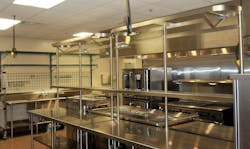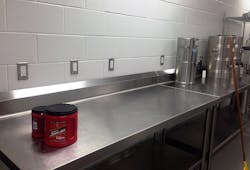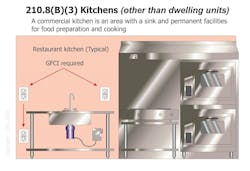Whether they’re part of local establishments or a national chain, permits for new restaurants are a constant source of inspections for many jurisdictions. Either way, there are always several restaurants in some stage of plan review or field inspection (Photo 1).
Inspectors who inspect a large quantity of restaurants tend to see the same defects repeatedly. In one respect, that’s a good thing because the inspector learns what is typically wrong and can focus on those specific issues. Knowledge of the most common installation errors can also inform the plan reviewer as to what to examine and focus more closely on during that stage.
New code requirements frequently are the driver for plan review comments or field inspection correction notices. Old habits can be hard to break, and humans are not always adept at change. Therefore, it often takes some time for designers, installers, and inspectors to internalize code changes and put them into practice. For that reason, we pay special attention to new or altered National Electrical Code (NEC) requirements applicable to a restaurant-type occupancy. One recent change — and one related previous change — are the drivers for a common violation in new restaurants.
New language was added to the parent text at Sec. 210.8 of the 2011 edition of the NEC. Beginning with the 2011 NEC, ground-fault circuit interrupters (GFCI) were required to be installed in a readily accessible location. Readily accessible, as defined in Art. 100, means that no obstacles will be located such that a person cannot quickly reach the referenced equipment. For a GFCI receptacle, this would mean that the receptacle is visible and can be reset or tested without having to remove equipment or appliances. GFCI protection of all 125V, single-phase, 15A and 20A receptacles located in commercial kitchens became a requirement with the 2002 NEC (Photo 2). This information is found in Sec. 210.8(B)(3).
The requirement that all 125V, single-phase, 15A and 20A receptacles be GFCI protected, combined with a newer requirement that GFCI devices are readily accessible, has resulted in the most common correction notice for new restaurants (commercial kitchens) — the reason being that these GFCI receptacles are not being installed in readily accessible locations. Many times, they end up buried behind large kitchen equipment or appliances and cannot be considered readily accessible. This can be a big problem at final inspection when the owner is seeking to gain occupancy and open the restaurant as soon as possible.
Relocating receptacles is not always easy when all building components are in place. For this reason, we highlight the readily accessible requirement to the designer during the plan review stage and go over the requirement with the installer at rough inspection. Even with that level of oversight, we still end up writing too many correction notices (Photo 3).
Many designers solve the GFCI readily accessible challenge by specifying branch-circuit overcurrent protection in the form of a circuit breaker that includes GFCI protection for the kitchen circuits. Use of GFCI circuit breakers can also be an effective solution when the specified GFCI receptacles were not, or could not be, installed in a readily accessible location.
Just be sure that the supplied GFCI circuit breakers provide Class A (4mA to 6mA) protection. We have seen on more than one occasion situations where the supplier provided Class B (30mA) GFCI circuit breakers intended for equipment protection instead of the required Class A GFCI circuit breakers. For further reading on this topic, visit
www.iaei.org and check out the article entitled “GFCI Circuit Breakers for Commercial Kitchens” from the August 2015 edition of the IAEI News magazine.
Being aware of newer Code requirements and where the problems tend to occur when designing/installing electrical equipment are invaluable elements to providing electrical protection to restaurant employees and guests.
Jackson is the chief electrical inspector for the city of Bakersfield, Calif. He holds five electrical inspector certifications through the IAEI and ICC and has instructed apprentice and journeyman electricians through the Kern County JATC for seven years. Jackson holds memberships in IAEI, NFPA, ICC, IBEW and serves as an AHJ representative on more than 20 Standards Technical Panels for Underwriters Laboratories. He represents the IAEI as a principal member of NEC Code-Making Panel 8.
Inspector Intel articles are provided by the International Association of Electrical Inspectors (IAEI), www.iaei.org, a membership-driven, non-profit association headquartered in Richardson, Texas, that promotes electrical safety throughout the industry by providing education, certification of inspectors, advocacy, partnerships, and expert leadership in electrical codes and standards.
About the Author
Pete Jackson
Electrical Inspector
Jackson is the chief electrical inspector for the city of Bakersfield, Calif. He holds five electrical inspector certifications through the IAEI and ICC and has instructed apprentice and journeyman electricians through the Kern County JATC for seven years. Jackson holds memberships in IAEI, NFPA, ICC, IBEW and serves as an AHJ representative on more than 20 Standards Technical Panels for Underwriters Laboratories. He represents the IAEI as a principal member of NEC Code-Making Panel 8.




